Exploring the Wonders of Seagrass: The Exe’s Underwater Meadows
Wildlife Wardens Imo & Sama recently attended a fantastic conference on seagrass - the inaugural UK Seagrass Symposium hosted by Ocean Conservation Trust and Cornwall Wildlife Trust at the National Marine Aquarium in Plymouth. It was such an inspirational experience, we thought we’d share a little about what we learnt in this edition of Shores, Heaths & Dunes!
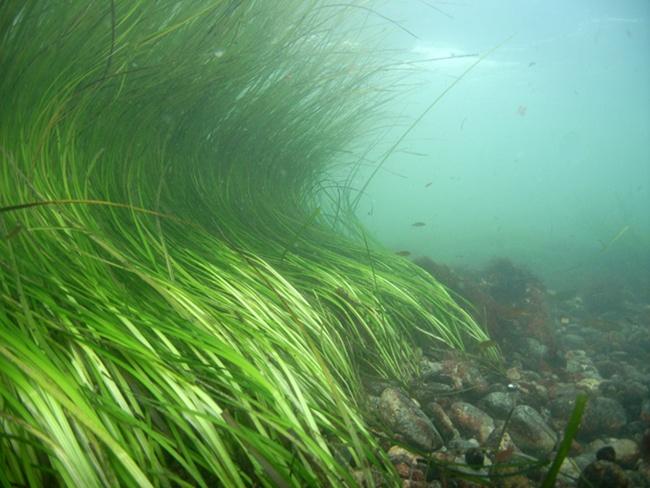
I’m sure many of us will already know about the significance of seagrass as blue carbon capture due to the many stories in the national press – and yes, seagrass can capture carbon up to 35 times faster than tropical rainforests (under the right conditions)! Want to know more about this amazing habitat? Read on!
What is seagrass? Seagrasses are unique flowering plants that are salt tolerant: this allows them to live in seawater and pollinate despite being submerged! Globally, there are around 45 different species, with the UK hosting three and the Exe specifically featuring one species: Zostera noltei (dwarf eelgrass).
Just like terrestrial plants, seagrass photosynthesises. Optimal growing conditions require clear, shallow water which sunlight can easily penetrate. In the tropics, seagrass can form expansive, flowing underwater meadows, growing up to 6 feet long. Here on the Exe, our seagrass is a little more modest, but equally as valuable to ecology.
There are a huge number of benefits that a seagrass meadow brings to both people and wildlife. Renowned as one of the most biodiverse habitats globally, seagrass meadows function as vital food source and habitats for rare species such as pipefish and seahorse. Meadows serve as nurseries for juvenile fish and can contribute to the enhancement of depleted fish populations. The intricate root systems formed play a stabilizing role in sediment, effectively mitigating coastal erosion.
Seagrass is hugely important in combating climate change: it takes in carbon dioxide from the ocean and stores it within its roots and leaves. By encouraging the growth of seagrass, we are helping to mitigate climate change and reduce ocean acidification. Seagrass also keeps us breathing by releasing oxygen – 10 litres per 1m2 everyday to be exact. Impressive!
Here on the Exe, a section of the seagrass meadow is protected as Exmouth Wildlife Refuge and is part of the reason we request that you avoid entering this area from mid-September to the end of the year. Eelgrass is the main foodplant of many of our overwintering species, including Dark-bellied Brent geese and Wigeon. Watch them feeding on this plant, by visiting Exmouth Duck Pond around 2 hours after high tide. Remember to keep a safe distance and watch from the shore so as not to disturb them.
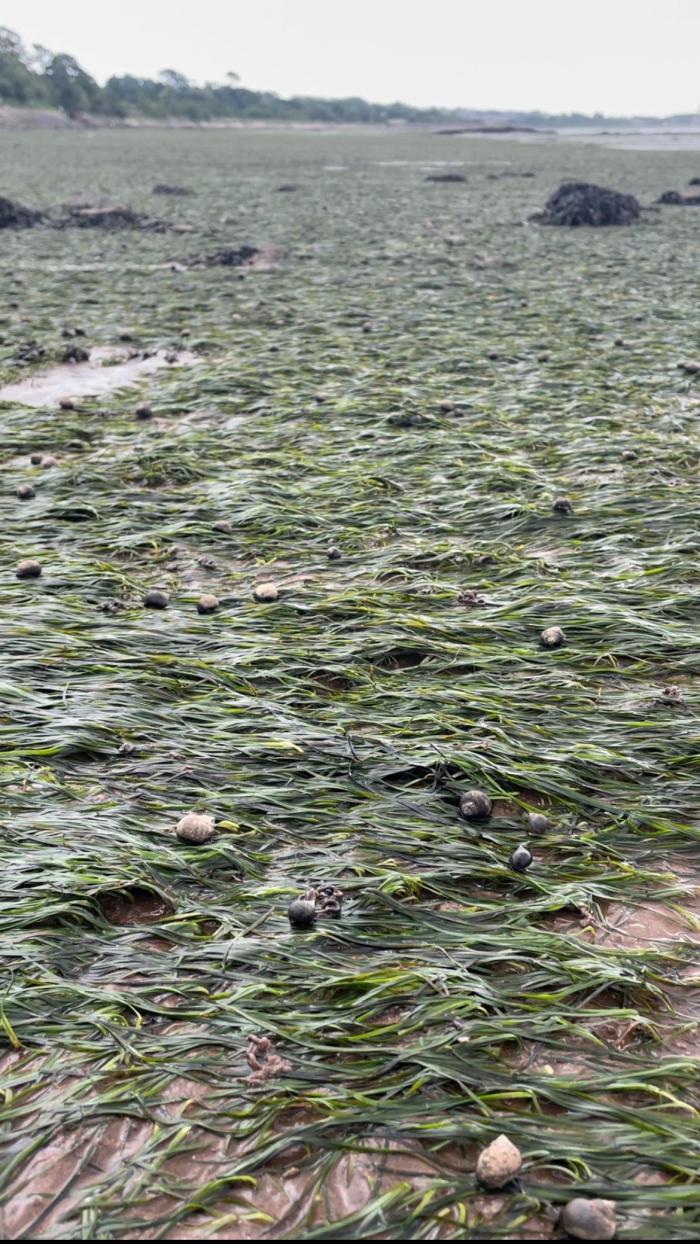
A habitat under threat: Despite its ecological significance, seagrass is a habitat under pressure.
During the 1930s, a wasting disease led to a 90% loss of temperate seagrass meadows. This had a devastating effect right up the food chain and the impact on populations of Dark-bellied Brent geese is well documented. These habitats really matter!
Presently, the UK still experiences an annual loss of approximately 500 hectares - mostly due to avoidable activities such as pollution, the scouring effect of traditional mooring systems, trawling, and the exacerbation of storms due to climate change.
Conservation measures: There is huge hope for the future: We heard updates from numerous research projects underway across the UK, looking at seagrass conservation and the re-seeding of seagrass meadows where they have been lost. It’s a process of trial and error, with each site providing different challenges, but research teams are working together and connecting in networks - including the Seagrass Symposium we attended, which will now happen annually.
It is estimated that in the UK, our seagrass extent has the potential to increase from the currently mapped 3167 hectares to 38000 hectares!
Ocean Conservation Trust are leading research on advanced mooring systems, or eco moorings, which prevent mooring chains dragging on the seafloor and uprooting seagrass. No anchor zones over seagrass meadows are being trialled in many locations, including Falmouth Harbour & Plymouth Sound National Marine Park. Finally, a transition to less destructive fishing methods would also allow the sea floor to recover naturally.
Here on the Exe: The health and extent of the eelgrass beds are monitored and mapped by the Environment Agency. We are eagerly awaiting the publication of the most recent report, which is imminent. In the meantime, we will continue to protect our eelgrass beds as part of the Exmouth Wildlife Refuge – by giving overwintering birds space to feed undisturbed, we minimise the impacts of recreation on these internationally important populations and the habitat they depend on.
Wildlife-friendly gifting.
By the time you receive the newsletter, Christmas will be coming up fast but just in case you still have a few presents to get, we thought we’d give you a few extra ideas for people who might be interested in wildlife as well as anyone you just don’t know what to buy for!

The RSPB shop at Darts Farm is a great location for a spot of shopping, as well having some lovely wintery walks in the surrounding countryside. The wardens are loving the ‘Icy avocets’ and ‘Winter waders’ Christmas cards (see below) but there are also other more familiar birds such as robins.
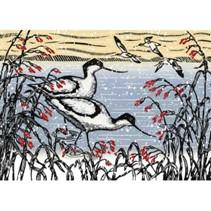
For the person, who has everything, what about a bird box or an insect hotel? There’s a variety of bird boxes suitable for swallows, robins, even tawny owls as well as solitary bees, and they can be installed on trees, buildings or even fences. Instructions on height and the best orientation will be on the nest box.
In the winter, birds particularly need a source of water as many of their usual places to drink will be frozen, so giving a gift of a bird bath for someone to put in their garden is great for the birds but also makes seeing birds from the comfort of the house so much easier. The RSPB have a variety of bird baths in their shop including high decorative stone and cast baths on plinths to a marble effect dish that can be placed on the ground or a dish which is hung by chains from a tree or hook within the garden.
What about a beautiful coffee table book as a present? The book that accompanies the BBC series Wild Isles about the wildlife in the British Isles is available from the RSPB, and would be a wonderful source of ideas about where to go to see some of Britain’s most spectacular wildlife.
And for children, there’s Amazing Animal Journeys by Chris Packham, all about animal migration and the incredible journeys that animals ranging from whales to butterflies make. Travel around the world, meeting the different animals and finding all about where they go and why.
If you’d prefer an experience type present, how about a gift voucher for the Stuart Line? Gift vouchers can be purchased in increments of £5, £10, £20, £25 or £50 up to any amount. Vouchers can also be purchased for a specific boat trip and where possible can include a delicious Devon Cream Tea! Between November and March, guided boat trips are undertaken on the Exe estuary where they see 1000’s of birds that migrate to the estuary to feed. The tours are led by a team of expert bird watchers and are suitable for beginners and more experienced bird watchers. Stuart Line Cruises: Devon Tourist Attraction: Boat Trips & Charter
Finally, to wrap all your gifts up, there’s a selection of lovely printed 10m rolls of recycled Christmas wrapping paper, moonlit owls is particularly festive!
Reasons to be joyful: Conservation success stories!
Feeling a bit glum? Fed up of the inclement weather? Here are 5 quick pick-me-ups to help you feel positive about conservation locally.
Avocets breed at Seaton Wetlands – a Devon first!
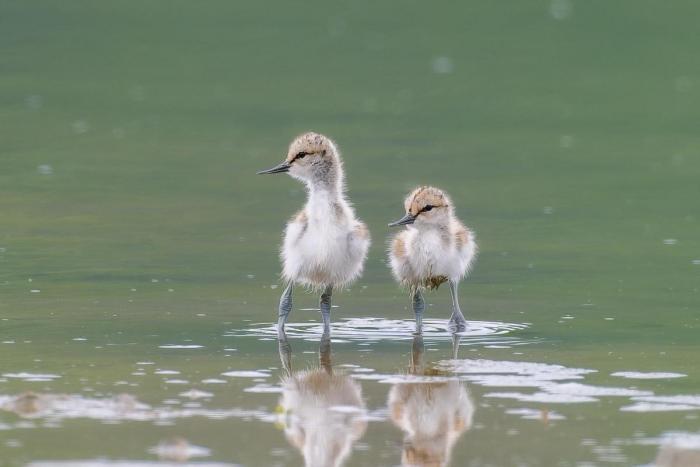
Back in June, two fluffy avocet chicks successfully fledged at East Devon nature reserve, Seaton Wetlands. This is the very first record of Avocet breeding in Devon and we are absolutely thrilled for our Countryside colleagues and all the hard-working volunteers involved. A huge win for local nature!
- Avocets feed on small shrimps and invertebrates – sweeping their slender, upturned bill from side-to-side across the surface of mud or shallow water to feel for prey. Supper by dainty dance!
Oystercatchers, another of our iconic species, also breed on the lagoon at Seaton. This year a record five pairs fledged chicks, a 60% increase on 2022.
Avocets hatch on Seaton Wetlands in Devon for the first time | Great British Life
Dormice in East Devon buck the national trend
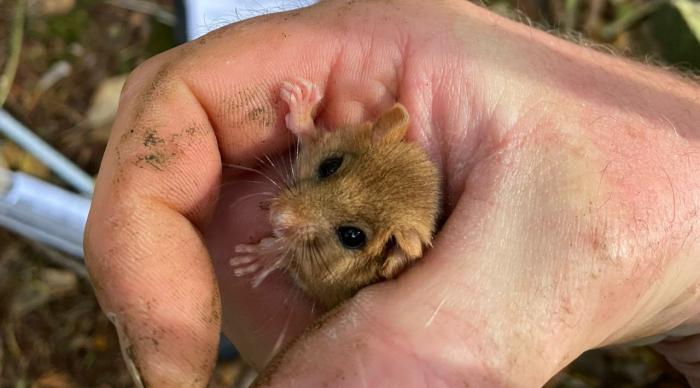
Surveying at East Devon nature reserves, Knapp Copse & Holyford Woods, returned positive numbers of dormice this season!
East Devon is a hotspot for dormice thanks to its extensive woodland cover. Our network of healthy, species rich hedgerow provides critical interconnection between sites across the wider landscape – important so pockets of dormice don’t become isolated from each other.
The future of this sleepy species is precarious: records from the People's Trust for Endangered Species report declines of 70% since 2000, with a total loss from 20 English counties – a devastating statistic!
Habitat loss and degradation, along with climate change, are recognised as the main reasons for this, but with the ongoing commitment to protect and restore habitat in East Devon, we are hopeful for the future.
24 November 2023 - Endangered dormice thrive in East Devon’s nature reserves - East Devon
Lundy Island bird numbers reach 9 decade high
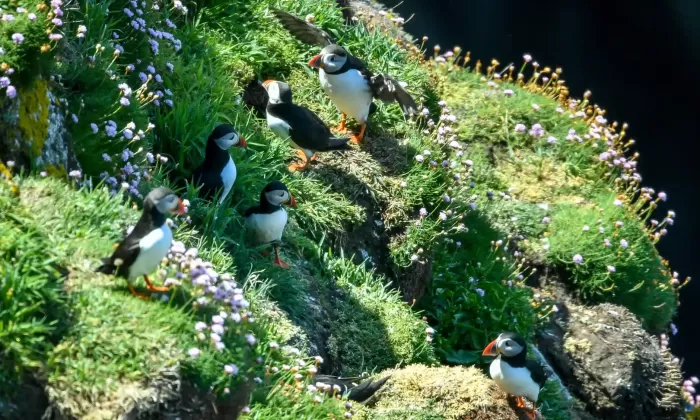
A project led by the RSPB, Natural England, the Landmark Trust & the National Trust on Lundy Island, off the North Devon coast, celebrates another brilliant year for conservation:
- Puffins, which were recorded at just 13 individuals in 2000, have now recovered to 1335 birds! Eradication of rats, which prey on eggs and chicks, has been cited as the main reason for this success.
- Storm Petrels, which first arrived on Lundy in 2014, have risen in number to over 150 pairs.
- Surveys have shown that Lundy now supports 95% of England’s breeding Manx Shearwaters, with 25,000 individuals recorded, up from <600 in 2001
- Incredibly, despite the backdrop of a range of pressures on our seabirds including Avian Influenza, the number of species on the islands continue to increase as other rare birds are attracted to this nesting colony.
Over 40,000 rare seabirds birds now call Lundy Island home, the highest number since the 1930’s, showing the impact that direct conservation can have in protecting and restoring species.
Paul St Pierre, RSPB conservation officer, is quoted as saying: "If we can restore over 30,000 birds to one small island in the Bristol Channel, just imagine how much could be achieved if everyone came together to restore nature right across the UK.”
"Projects like this are achieved through decades of conservation science, expertise, funding and countless volunteer hours.”
"Everyone can play a part."
Paul – we couldn’t agree more! A huge thanks to everyone across the district, nationally and throughout the world, who commits volunteer time to conservation. You are our heroes!
‘Shear’ success for Lundy’s seabirds thanks to decades of conservation effort - Inside Ecology
Exmouth Wildlife Refuge records record bird numbers again for 2023
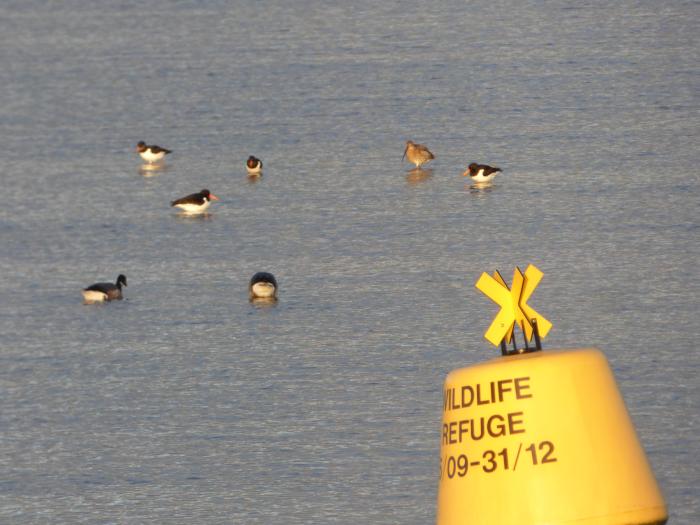
The Wildlife Refuge at Exmouth duck pond enters its 6th year and continues to support the overwintering waterbird community of the Exe estuary Special Protection Area.
- Top stats recorded for this site this year include more than 1000 Dark-bellied Brent geese - a species that travels more than 3000km from their breeding grounds in Artic Siberia to winter with us on the Exe.
- Several hundred Oystercatcher have been reported, with good numbers of Curlew, Redshank, Greenshank, Black-tailed Godwit, Dunlin, Turnstone & Ringed plover spotted feeding close to the shore.
- Flocks of several thousand Wigeon have been visible feeding at mudbank with Pintail, Mallard and Shelduck amongst them.
- Great crested grebe and grey plover have also been seen in the refuge this year!
The continued support from the Exmouth community can be credited with this success, with special credit to anyone who has avoided walking their dog along the beach at Exmouth Duck Pond and the many watersports enthusiasts who have respected the boundaries of the refuge over the past months. This good news story is all down to you lot so a huge thank you from the Wildlife Warden team!
Edge Watersports and Exmouth Watersports definitely deserve special mention for their continued support in spreading the message to remain out of this area between Sept 15th & Dec 31st to give our waterbirds space to rest and feed undisturbed during the winter months. Thanks guys!
There is still time to see the amazing winter spectacle of birdlife on the estuary – the voluntary ‘no-go’ area at Exmouth Wildlife Refuge runs until Dec 31st, but our wintering birds remain on the Exe until the Spring.
Exe Estuary Wildlife Refuges | South East Devon Wildlife
Landscape regeneration – wetland creation on the Otter estuary
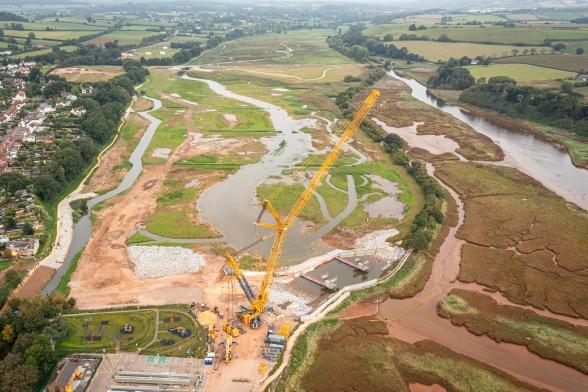
One of the biggest coastal climate adaptation and habitat creation projects in England - The Lower Otter Restoration Project (LORP) - is nearing completion. This ground-breaking project, formed of a partnership between local landowners Clinton Devon Estates and the Environment Agency, has restored the historic floodplain of the Otter estuary near Budleigh Salterton, East Devon, creating a smashing 55 hectares of wetland habitat.
- Newly created mudflats will provide rich feeding grounds for wading birds like black-tailed godwits, dunlin and redshank.
- Inter-tidal habitats are also well known for being able to store large amounts of carbon, helping to combat the climate crisis.
- It’s hoped that restoration of this flood plain will alleviate issues with local flooding after heavy rain
Dr Sam Bridgewater, of Clinton Devon Estates said: "After more than a decade of planning and hard work, it is fantastic to see the project nearing completion. The benefits for people and the planet are already clear to see. It's really encouraging that a wide variety of bird species have been visiting the site and we look forward to seeing further wildlife gains as the landscape and habitats develop."
Home: Lower Otter Restoration Project
Look out for...
Fieldfare
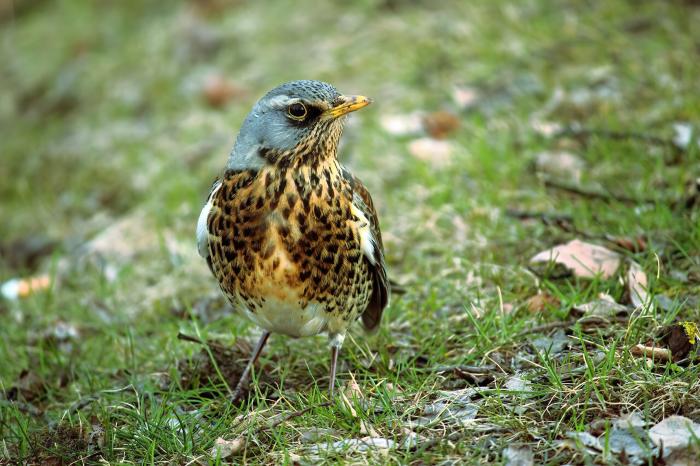
A large colourful thrush, much like a mistle thrush in size, shape and behaviour. They breed in western Russia and eastern Europe and arrive here in early October in search of windfall apples and berries. They are usually seen on the Pebblebed Heaths and on farmland but can be found in gardens when the temperatures are particularly cold. They are very social birds spending the winter in flocks of between 10 to several hundred strong.
Starling
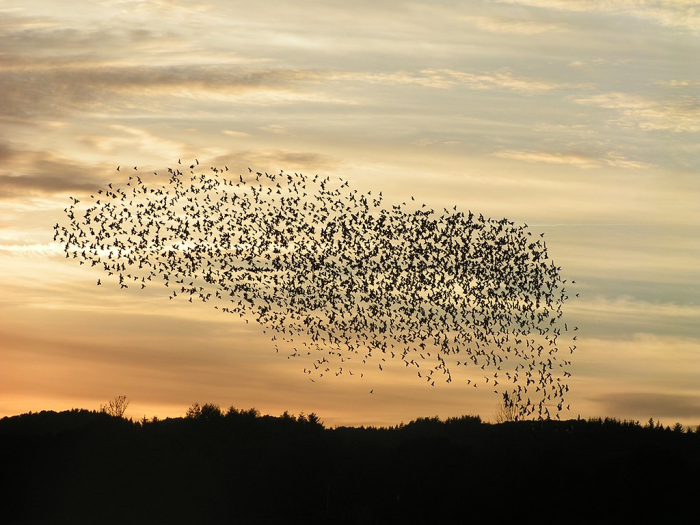
Smaller flocks of starlings are around all year round, but winter is the time to see the spectacular large flocks of starlings (known as murmurations) that visit Britain from the continent seeking out the relative warmth of our island climate. As dusk arrives, the starlings set off from their communal roost in one of the most amazing natural spectacles of all. Flocks arrive in all directions, gathering in the sky above the roost and as the numbers reach into the tens and hundreds of thousands, the flock starts to swirl around in the sky making incredible shapes.
The sound of thousands of tiny wings above is amazing but careful if you’re watching the flocks from below, as there’s a high likelihood of getting pooed on! As the numbers reach their peak and the last of the light fades, the birds suddenly decide that the time is right and funnel down into the reeds in one last whoosh of wings and calling birds and the show is over.
Places to see the murmuration’s include the reedbeds on the River Exe or on White Bridge at Budleigh Salterton.
Wigeon
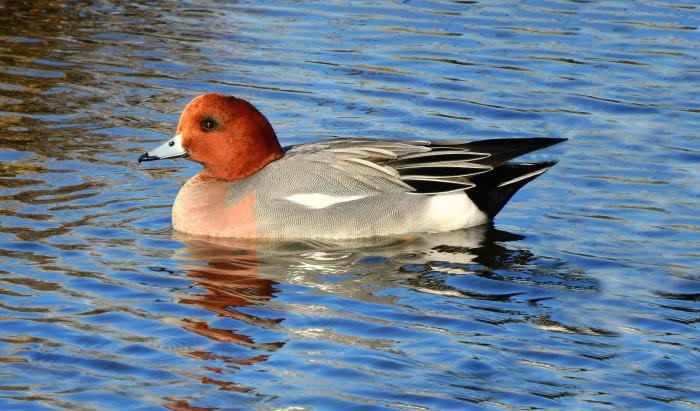
Wigeon congregate in their thousands at Exmouth Mud Bank & at RSPB Bowling Green Marsh over the winter. They have a distinctive whistling call, very different from the familiar quacking call of mallard! They are a medium sized, colourful duck with a round head and a small bill.
Males have a grey and white body with a chestnut brown head and a distinctive yellow stripe over their foreheads. Females wigeon can look similar to female mallards, with rusty brown feathers. They breed in northern England and Scotland as well as Iceland, Russia and Scandinavia.
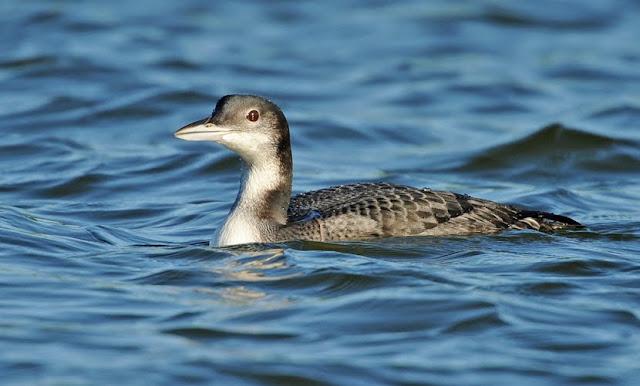
Divers looks a bit like cormorants when they’re swimming with a long neck and a body which sits low to the water. They are however much larger, with a thick neck and a heavy bill. When watching birds in profile, look for the bump they have on their foreheads.
Northern divers breed in Greenland, Iceland and north America (where they are known as Common loons) and come to the coasts of UK in the winter. They have a very spooky sounding call, often used in horror films! Best place to spot: look off the beach at Dawlish Warren.